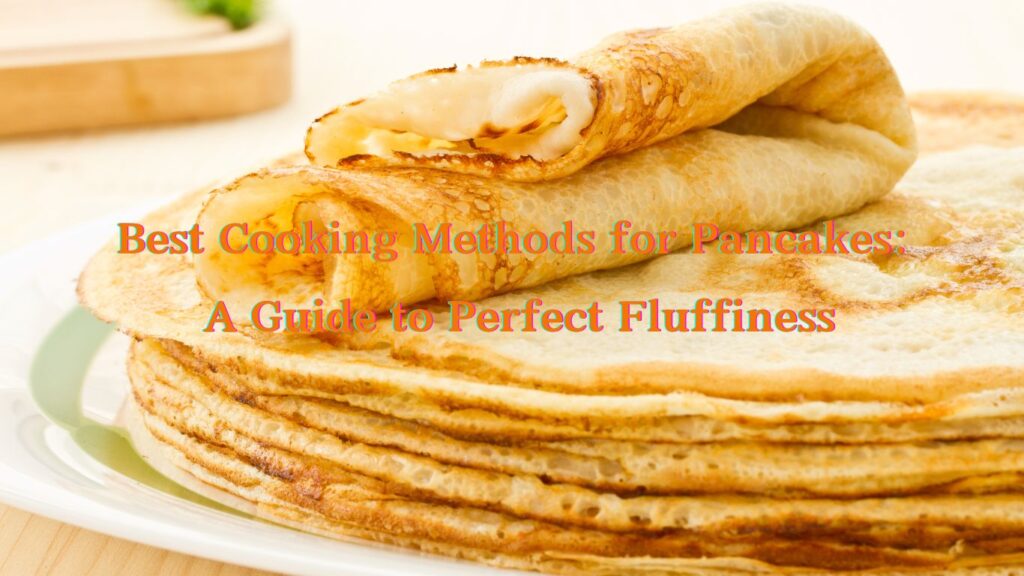We use affiliate links. If you purchase something using one of these links, we may receive compensation or commission.

Introduction
“Pancakes are a popular breakfast food that is loved by people all around the world.”From fluffy American stacks dripping with syrup to thinner, crepe-like versions in Europe, pancakes’ versatility is truly impressive. This article delves into the cooking methods that can make or break your pancake game. Whether you’re a novice or a seasoned chef, understanding the proper techniques is critical to achieving that perfect fluffiness.
Cooking Method for Pancakes
The Basics of Pancake Cooking
Pancakes generally require a straightforward cooking process that involves a hot surface and a batter made from flour, eggs, milk, and a leavening agent. The aim of success is to create a light, airy texture with a slightly crispy exterior. The most commonly recommended method is using a griddle or a frying pan.
Griddle vs. Frying Pan
Griddle Method
Using a griddle is often the preferred method for cooking pancakes due to its large, flat surface. This allows for better heat distribution and space to cook multiple pancakes simultaneously. The consistent temperature helps ensure each pancake cooks evenly, reducing the risk of raw or burnt spots.
Frying Pan Method
A frying pan can also yield excellent results. The key is to use a heavy-bottomed pan that retains heat well, such as cast iron. Lightly brush the pan with olive oil or butter before each pancake to ensure that it doesn’t stick, and add a bit of crispness to the edges.
Maintaining the correct temperature is crucial. It’s too hot, and the pancakes will burn on the outside before cooking through. Too cool, and they won’t get that delicious golden-brown crust. Aim for medium heat, or approximately 375 degrees Fahrenheit, on an electric griddle.
Flipping Techniques
The flip is crucial in pancake cooking. Wait until bubbles form on the surface and the edges begin to look set before flipping. This usually means the bottom has browned perfectly, and the pancake is ready for its second side.
Incorporating Cooking Techniques in Your Pancake Routine
Making the Perfect Batter
The batter consistency is vital. It should be thick enough to hold its shape on the griddle but not so dense that it doesn’t spread slightly. It’s a delicate balance that might take a few tries to perfect.
Creative Variations
Once you have mastered the basic pancake, you can start experimenting. Additions like blueberries, chocolate chips, or bananas added to the batter make for delicious variations.
Nutritional Considerations
Switching up the ingredients can offer more nutritional benefits. Using whole wheat flour, adding oats or flaxseeds, or substituting dairy milk for almond or oat milk are great ways to enhance your pancakes’ health profile.
Advanced Pancake Cooking Techniques
Alternative Cooking Methods
Oven-Baked Pancakes
For those who prefer a hands-off approach, oven-baked pancakes can be a great alternative. This method is beneficial for making Dutch babies or large-format pancakes that serve multiple people.
Pancake Molds and Rings
Using molds or rings can help in achieving perfectly round pancakes or fun shapes that are especially popular with kids.
International Pancake Styles
Exploring international pancake varieties can also enhance your cooking repertoire. For instance, the French crepe requires a thinner batter and a slightly different cooking technique, such as using a crepe pan over medium heat.
Troubleshooting Common Pancake Issues
From batter sticking to the pan to pancakes that are too dense, understanding how to troubleshoot common issues can help keep your pancake breakfasts stress-free.
Conclusion
Mastering the pancake cooking method does not just end with choosing the right equipment or flipping at the right time. It’s about experimenting with ingredients, temperatures, and even cultural cooking styles to find what works best for you. Whether it’s a Sunday family breakfast or a quick weekday meal, pancakes offer a delicious versatility that’s hard to beat.


